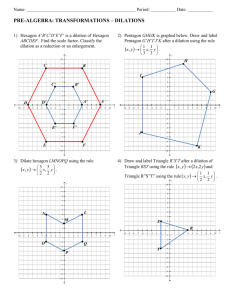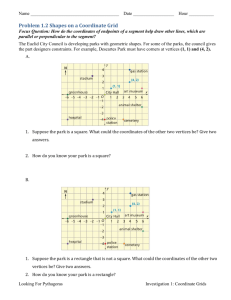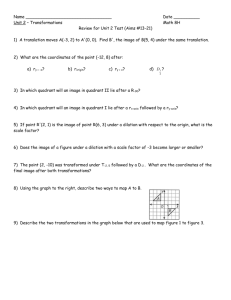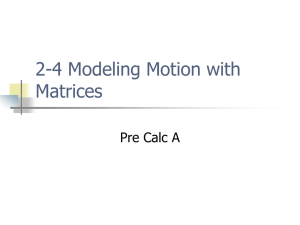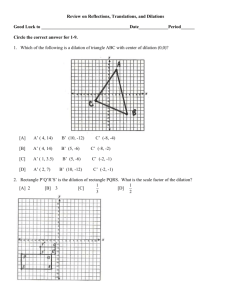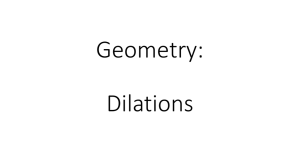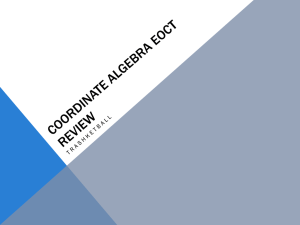Study Guide – Rules for Transformations on a Coordinate Plane
advertisement
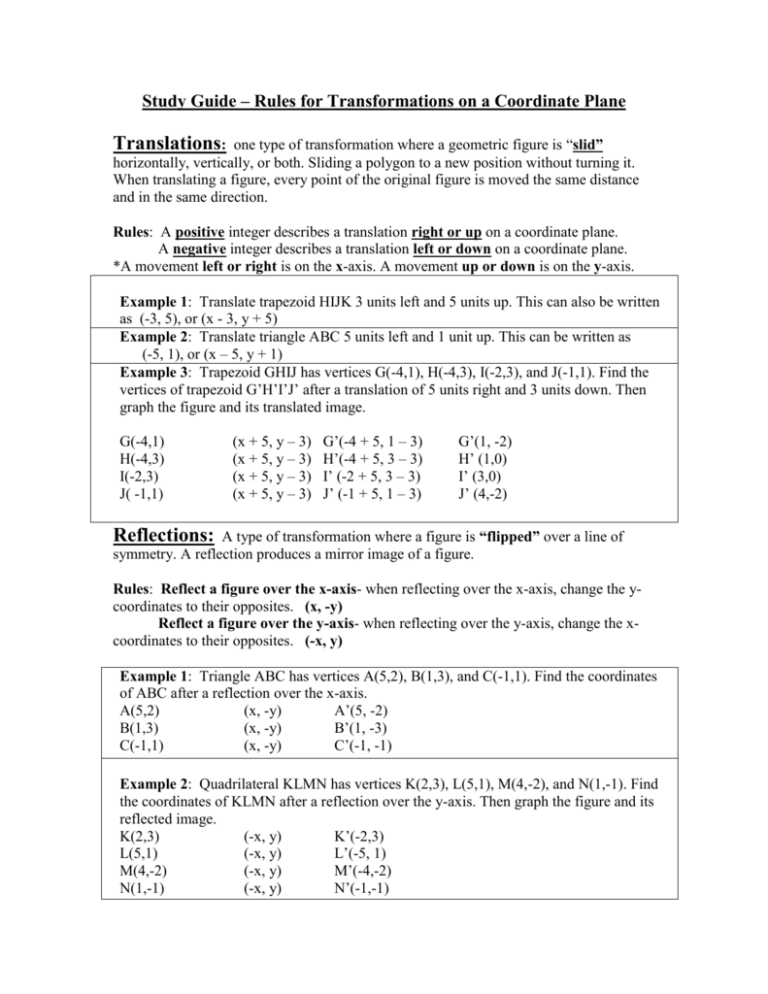
Study Guide – Rules for Transformations on a Coordinate Plane Translations: one type of transformation where a geometric figure is “slid” horizontally, vertically, or both. Sliding a polygon to a new position without turning it. When translating a figure, every point of the original figure is moved the same distance and in the same direction. Rules: A positive integer describes a translation right or up on a coordinate plane. A negative integer describes a translation left or down on a coordinate plane. *A movement left or right is on the x-axis. A movement up or down is on the y-axis. Example 1: Translate trapezoid HIJK 3 units left and 5 units up. This can also be written as (-3, 5), or (x - 3, y + 5) Example 2: Translate triangle ABC 5 units left and 1 unit up. This can be written as (-5, 1), or (x – 5, y + 1) Example 3: Trapezoid GHIJ has vertices G(-4,1), H(-4,3), I(-2,3), and J(-1,1). Find the vertices of trapezoid G’H’I’J’ after a translation of 5 units right and 3 units down. Then graph the figure and its translated image. G(-4,1) H(-4,3) I(-2,3) J( -1,1) (x + 5, y – 3) (x + 5, y – 3) (x + 5, y – 3) (x + 5, y – 3) G’(-4 + 5, 1 – 3) H’(-4 + 5, 3 – 3) I’ (-2 + 5, 3 – 3) J’ (-1 + 5, 1 – 3) G’(1, -2) H’ (1,0) I’ (3,0) J’ (4,-2) Reflections: A type of transformation where a figure is “flipped” over a line of symmetry. A reflection produces a mirror image of a figure. Rules: Reflect a figure over the x-axis- when reflecting over the x-axis, change the ycoordinates to their opposites. (x, -y) Reflect a figure over the y-axis- when reflecting over the y-axis, change the xcoordinates to their opposites. (-x, y) Example 1: Triangle ABC has vertices A(5,2), B(1,3), and C(-1,1). Find the coordinates of ABC after a reflection over the x-axis. A(5,2) (x, -y) A’(5, -2) B(1,3) (x, -y) B’(1, -3) C(-1,1) (x, -y) C’(-1, -1) Example 2: Quadrilateral KLMN has vertices K(2,3), L(5,1), M(4,-2), and N(1,-1). Find the coordinates of KLMN after a reflection over the y-axis. Then graph the figure and its reflected image. K(2,3) (-x, y) K’(-2,3) L(5,1) (-x, y) L’(-5, 1) M(4,-2) (-x, y) M’(-4,-2) N(1,-1) (-x, y) N’(-1,-1) Rotations: A transformation that “turns” a figure about a fixed point at a given angle and a given direction. Rules: 90 degree clockwise rotation around the origin (0,0), use: (y, -x) 180 degree rotation around the origin (0,0), use: (-x, -y) 270 degree clockwise rotation around the origin (0,0), use: (-y, x) Example 1: Triangle NPQ has vertices N(0,0), P(4,-1), and Q(4,2). Rotate clockwise 90 degrees. N(0,0) (y, -x) N’(0 ,0) P(4,-1) (y, -x) P’(-1, -4) Q(4,2) (y, -x) Q’(2, -4) Example 2: Triangle KLM has vertices K(1,0), L(4,2), and M(3,4). Rotate 180 degrees. K(1,0) (-x, -y) K’(-1,0) L(4,2) (-x, -y) L’(-4,-2) M(3,4) (-x, -y) M’(-3,-4) Example 3: Quadrilateral DEFG has vertices D(-1,0), E(-4,1), F(-3,3), and G(0,4). Rotate clockwise 270 degrees. Graph DEFG and D’E’F’G’. D(-1,0) (-y, x) D’(0, -1) E(-4,1) (-y, x) E’(-1, -4) F(-3,3) (-y, x) F’(-3, -3) G(0,4) (-y, x) G’(-4, 0) Dilations: a transformation that changes the size of a figure, but not the shape. Rule: To dilate a figure, always MULTIPLY the coordinates of each of its points by the percent of dilation. **First change the percent to a decimal (move the decimal point TWO places to the LEFT. **Next, multiply each of the coordinates by that number. Example 1: Triangle ABC has vertices A(-2, 2), B(-1, -2), C(-6, 1). What are the new coordinates after a dilation of 150%? Change the percent to a decimal: 150% = 1.50 A’(-2 x 1.5, 2 x 1.5) B’(-1 x 1.5, -2 x 1.5) C’(-6 x 1.5, 1 x 1.5) A’(-3, 3) B’(-1.5, -3) C’(-9, 1.5) Example 2: Triangle XYZ has vertices X(-4, 3), Y(2, 3), Z(-3, 1). What are the new coordinates after a dilation of 75%? Change the percent to a decimal, then multiply: 75% = .75 X’(-4 x .75, 3 x .75) Y’(2 x .75, 3 x .75) Z’(-3 x .75, 1 x .75) X’(-3, 2.25) Y’(1.5, 2.25) Z’(-2.25, .75) Example 3: Triangle XYZ has vertices X(12, 20), Y(24, 4), Z(4, 16). If the new coordinates after a dilation are X’(3, 5), Y’(6, 1), Z’(1, 4), what was the percent of dilation? Rule: Divide the coordinates of the image by the coordinates of the original figure to determine the percent of dilation. X (3/12, 5/20) Y (6/24, 1/4) Z(1/4, 4/16) Percent of Dilation: 25%

